This fascinating little wildcat, which has been called one of the most expressive felines, has a full repertoire of quirky facial expressions. To enlighten you about this little creature, you are offered some Pallas cat facts about a cat that might deserve the title of the world’s most grumpy cat. He doesn’t belong to any group — he’s solitary and wants to stay that way.
Where Are These Cats Located?
Pallas’s cats live throughout central Asia. Mongolia has perhaps the largest population of this cat, though Russia also has quite a number. In Russia, this cat holds celebrity status, as he has played the role of mascot of the Moscow Zoo for over 30 years.
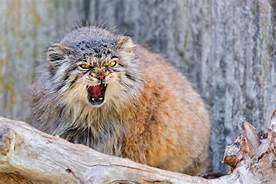
The Pallas Namesake
This cat got his name from Peter Simon Pallas, a German zoologist. Pallas became part of the first Russian Siberian expedition that surveyed the Russian Empire in the late 18th century. Pallas became the first to describe the animal; thus this cat received his name.
His Latin name is otocolobus manul, also known as the manul cat.
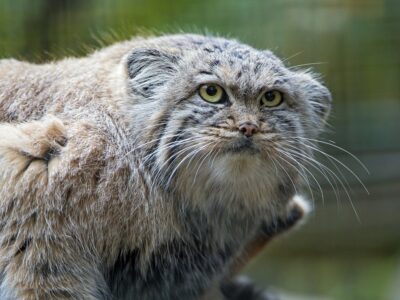
Pallas’s cat’s surley expression helped earn him the dubious title of grumpy cat. Part of his appearance creates this distinction. He has a flat face, and large, oval-like eyes. The pupils are round, and keep the round shape even when the cat’s pupils narrow. Unlike the domestic cat, his eyes do not narrow to slits.
His long, dense fur makes him appear bigger than his actual size. If you cut off the fur, he would weigh in at about the same size as a domestic cat.
Other Appearance Features
The small cat weighs in at between five and nine pounds. Head and body length measurements range from 19.5 to 25.5 inches. His tail masures 8 to 12 inches long. The coat color ranges from light grey to a yellowish buff or even a russet. White tips to his hair gives it a frosted, silvery look.
Pallas’s cat has two dark streaks across each side of the head. The dark-tipped tail has four rings, and the cat has a coat that comes in longer and thicker than that of any other felid. His ears, small and rounded, lay very low on the sides of the head.
Habitat
The animal makes good use of his thick fur coat, as he spends a great deal of time lying on frozen ground and snow.
The physical attributes of Pallas’s cat adapts him best to cold, arid environments. He lives in alpine deserts, steppes and rocky country, up to fairly high elevations. Caves or crevices in rocks or burrows dug by other animals such as marmots furnish him with a place to call home.
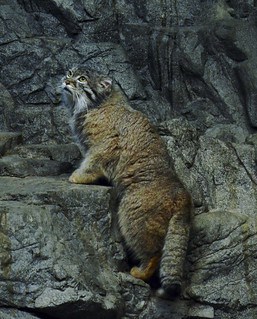
Though once thought to be nocturnal, the cat has now come to be considered crepuscular.
Where Is Their Territory?
Pallas’s cat can be found throughout Asia, from the Caspian Sea and Iran into southeast Siberia and Tibet. He has been found as high as 4,800 meters in cold, arid climates. He prefers valleys and rocky areas as these can provide some cover. The cat avoids completely open areas, as he would end up too exposed to hostile eyes.
Small Ears Have A Purpose
The cat’s small ears actually play a most important part in his survival. These small ears offer three advantages:
1) Large ears can cause a great loss of body heat, so the cat’s small ears close to the head helps preserve more warmth.
2) The cat must listen for rodents, so ears must alert them to these sounds.
3) Since the ears lay low on the side of the head, they can peer over an object and only a very small part of their head above the eyes will show.
Reproductive Cycle
Females become sexually mature at about one year of age. She only goes into heat for 26 to 42 hours. The gestation period lasts 66 to 75 days.
At the beginning of the breeding season, the male shows increased aggressiveness and territorial behavior. His testosterone levels get much higher during breeding season. At that time, his blood will contain three times more testosterone than during non-breeding season.
Between the end of April and late May, the pregnant female will give birth to a litter of two to six kittens. The newborn has fuzzy fur, and its eyes do not open until about the age of two weeks.
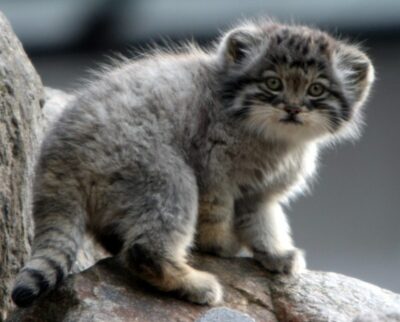
By the age of five months, the kittens will start to hunt, and will reach adult size by the age of six or seven months.
As these cats don’t socialize much, even with their own kind, once the kittens become ready to go out on their own, they live a solitary existence. The young live in the family group for up to a year after birth; then they are on their own.
What Are The Threats To This Cat?
This poor kitty has a number of reasons why its numbers have been reduced in the areas the cat inhabits. In fact, in some places it has been placed on the endangered list.
Here is a list of the threats it faces:
1) Humans hunt and kill them for fur and meat. Their fur has been used for coats, hats and gloves, and other accessories. People eat their meat and use their fat for cooking. Most of the killing occurs in winter because their fur will then reach its thickest.
2) Poisoning of the primary food source. The pika, in some places, is being poisoned because it could be a source for plague.
3) Killed by domestic or herding dogs.
4) Mining and other developments which interfere with their habitat.
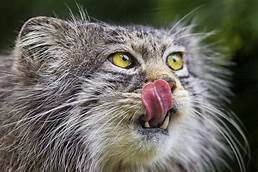
5) Demand as exotic pets. I believe that people should not try to domesticate this animal, as the cat can only really thrive in a specific habitat.
Let’s hope this animal does not become extinct because of too many people not caring about its survival. This grumpy little creature deserves to continue to inhabit its chosen home.
Look at this video to get a close-up view of this interesting little animal.
References I used for this post: animals.howstuffworks.com/mammals/pallas-cat.htm bigcatrescue.org/pallas-cat-facts/ wildcatconservation.org/wild-cats/eurasia/pallas-cat/ en.wikipedia.org/wiki/Pallas%278_cat

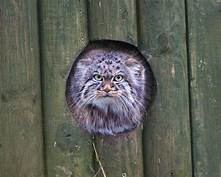
That was a very interesting article. I enjoyed the film at the end too. They are beautiful cats! Thanks for this excellent bit of research. I learned a whole bunch.
Thank you, KC. I, too, learned a great deal. It’s one advantage of writing these posts — I probably learn more than my readers. Pallas’s Cat certainly gives us a different view of a cat’s potential. I do love his coat, and can understand why he would be hunted for his fur, unfortunate though that is. Glad you found it interesting.